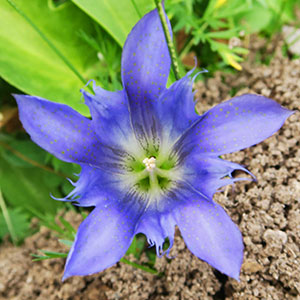Gentiana newberryi
Gentiana saponaria
alpine gentian, Newberry's gentian
harvestbells, moss gentian, soapwort gentian
1–5, arising laterally below rosettes, from a stout tap root, tufted, decumbent.
1–5, terminal from caudex, decumbent to erect.
basal and cauline;
blades of basal rosette and proximal cauline leaf blades widely spatulate to obovate or oblanceolate, 0.8–5 cm × 2–25 mm, apex obtuse or mucronate, at least these leaves with blades less than 6 times as long as wide, distal cauline leaves few, with blades oblanceolate to lanceolate or linear, 2–5 cm × 2–5 mm, apices acute.
cauline, ± evenly spaced;
blade linear to widely elliptic, 1.5–12 cm × 3–30 mm, apex obtuse to acute.
terminal, flowers usually solitary, occasionally 2 or 3.
± dense 1–8-flowered cymes or heads, sometimes with additional cymules on short branches.
calyx 14–30 mm, lobes linear to narrowly ovate, (4–)6–12 mm, margins not ciliate;
corolla white or blue, campanulate, open, 23–55 mm, lobes spreading, elliptic-obovate, 7–17 mm, free portions of plicae divided into 2 triangular, serrate to lacerate segments;
anthers distinct.
calyx 9–32 mm, lobes spreading nearly horizontally when fresh, narrowly oblanceolate, 4–17 mm, shorter than or ± as long as tube, margins ciliate;
corolla blue or rarely rose-violet, tubular, loosely closed to slightly or (in southernmost part of range) almost fully but narrowly open, 30–50 mm, lobes ovate-triangular, 3–7 mm, usually less than 2 mm longer than plicae, free portions of plicae divided 1/2 or more of their length into 2 subequal, erect, ± triangular, lacerate segments;
anthers connate.
winged.
winged.
= 26 (including plants identified as G. saponaria and G. cherokeensis).
Gentiana newberryi
Gentiana saponaria
Varieties 2 (2 in the flora).
The two varieties of Gentiana newberryi intergrade extensively. The most distinctive form of var. newberryi, with relatively tall stems and medium to deep blue corollas, occurs in the northern part of the range of the species, from the Klamath and White mountains of California north into Oregon. Plants most clearly referable to var. tiogana prevail in the southern part of the range of the species, from Butte County south to Inyo and Tulare counties, California. In the central part of the range of the species, plant size and corolla color are less consistently correlated, with occasional plants combining low stature with deep blue corollas or tall stems with predominantly white or pale blue corollas. In that part of the range, corolla color may be highly variable within a single population.
The leaves of Gentiana newberryi are thick-textured and distinctively concave, usually spoon-shaped, when fresh. Narrower leaves sometimes occur in var. tiogana, but many plants of that variety have widely spatulate leaves like those of var. newberryi.
(Discussion copyrighted by Flora of North America; reprinted with permission.)
Gentiana saponaria is believed to be extirpated from the District of Columbia. Reports from west of the range given here have been based mostly on specimens of G. andrewsii × G. puberulenta, occasionally on G. flavida × G. puberulenta or other hybrids. Some reports from the northeastern United States, including all records from Vermont and upstate New York, were based on specimens of G. clausa that antedate the recognition of that species in standard floras. Other reports have been based on misidentified G. linearis.
The name Gentiana puberula Michaux is typified by a specimen of G. saponaria but has generally been misapplied to G. puberulenta.
Plants from the northern parts of the range of Gentiana saponaria tend to have corollas more nearly closed than those from the southern parts of the range, but their corollas are not so firmly closed as those of G. clausa, the corolla lobes are larger, the summits of the plicae are usually more or less visible in herbarium specimens, and the shape of the calyx lobes is distinctively different. Plants of G. saponaria in the southernmost part of its range tend to have somewhat larger and more open corollas, approaching G. catesbaei in these respects, but they differ in their elliptic rather than ovate leaves and calyx lobes mostly shorter than or about as long as the tube rather than longer. Plants from bog and lake-shore habitats in Watauga County, North Carolina, at 1200 m, above the usual altitudinal range of G. saponaria, have attracted interest because of their linear to narrowly elliptic leaves mostly 3–9 mm wide. Their calyx and corolla morphology strongly supports their inclusion in G. saponaria, as does the occurrence of occasional plants with wider leaves in the same populations. Plants with similarly narrow leaves occur elsewhere in the range of G. saponaria and include those that have been identified as G. cherokeensis.
The epithet saponaria refers to a resemblance of the stems and leaves of this species to those of soapwort or bouncing-bet, Saponaria officinalis (Caryophyllaceae). Soaplike substances were not obtained from the gentian, so the invention of “soap gentian” as a common name is not appropriate.
Gentiana saponaria hybridizes with G. andrewsii relatively frequently in the Ohio Valley and occasionally elsewhere. Hybrids with G. catesbaei, G. clausa, G. decora, and G. puberulenta are also known.
(Discussion copyrighted by Flora of North America; reprinted with permission.)
1. Corollas medium to deep blue with greenish to dark purple lines abaxially on and below lobes, usually 35–55 mm. | var. newberryi |
1. Corollas white to pale blue except for greenish to dark purple lines abaxially on and below lobes, usually 23–42 mm. | var. tiogana |


